01.07.2020: It’s time again for the annual maintenance, time flies. HB-YNL is now 10 years old, with slightly more than 400 hours and roughly the same number of landings in the books. I had about 300 hours and landings after five years of operation, but the numbers per year have dropped significantly during the last five years due to my job and the frequent absences abroad. This year however looks better, I have already flown nearly 20 hours and it is only beginning of July.
There haven’t been any significant issues with the plane which would require special attention, so it is just a regular annual / 100 hrs check. The only extra item on the maintenance list is to weigh the aircraft, which has to be done every 10 years. This requires draining the fuel from both tanks, which I took as an opportunity to check the accuracy of the fuel level indication at lower fuel levels. When I refuel to maximum I always first check the remaining fuel in the tank and then calculate how much fuel should be added, which I then compare with the fuel it actually takes to fill up. This gives me an indication on how accurate the fuel reading is at different fuel levels, but it is not extremely accurate, and is rarely done from low fuel levels as I rather fly with too much fuel that with to little. Knowing that the maintenance is due I made sure that not too much fuel is remaining in the tanks, which was 15 liters in the left tank and 11 liters in the right one. I then drained the fuel tanks into canisters, on which the amount of fuel is indicated. The two canisters showed about 14.5 liters and 9.5 liters, which is pretty accurate compared to the 15 and 11 liters indicated.

Apart from that I did the regular 100 h / annual check, with no issues found whatsoever. The compression is fine on all four cylinders an no metal residue was found in the oil, in the oil filter or on the magnetic plug. And I also found no issues with the aircraft cell or the avionics.

In the evening we drove to Sitterdorf airfield, from where I could borrow the scales for the weighing of the aircraft, which is due tomorrow.
02.07.2020: This morning I first did the weighing, which showed that the plane has gained 4 kg in ten years. The only things I have changed during those years where the hoses, the battery charger and the mounting tray for the ELT, of which each might have added a bit of weight. And I also changed the battery twice, but I don’t think they became heavier as they were of the same type. Finally I also replaced the carpet in the rear baggage compartment, but that was a one by one replacement. The rest might be moisture in e.g. the seat cushions, a bit more fuel remaining in the tanks after draining or just the slightly different setup. The scales should’n have an impact, as they were the same ones I had used 10 years ago, and they have been calibrated recently. The empty weight including all liquids (oil, cooling water and approximately 2 liters of unusable fuel) is now 873 instead of 869 kg, which doesn’t really make a difference.
I might even reduce the weight again soon by a few kg, as I’m thinking of replacing the led battery with a Lithium type battery, which is significantly lighter.
Once the weighing was done I first did the engine run to close the annual checklist, followed by a short test flight. That confirmed that all is fine, no issues. were detected. We also checked the engine again after the check flight, which also confirmed that all is fine.
We then returned the scales to Sitterdorf, and took the chance to have a look at a Fieseler Storch they are working on. It is a huge aircraft, one that has flown with the Swiss Air Force and still flies with the original Argus 8 cylinder inverted V engine.

03.07.2020: Today I finished the paperwork of my annual maintenance. You have 30 days to do that after maintenance, but as I will have the bi-annual inspection in a few days I decided to do it quickly, in order to avoid any discussions.
04.07.2020: My friend from Denmark and I decided to go out for a day of flying today. We decided to try to see some mountains by fly to Samedan (LSZS) first, and then from there to Locarno (LSZL).
The weather was ok in Lommis, but GAFOR predicted that the Julier pass would remain closed until around noon, and be difficult to marginal to cross thereafter until some time in the afternoon. The general weather forecast predicted a broken layer of clouds at around 7’000 to 8’000 ft which would only partially disappear during the day. This however gave hope that there would be a chance to fly into the Engadin valley on top of the clouds.
Below a picture I took shortly after takeoff, looking south east.

We proceeded from Lommis via Wildhaus and Buchs towards Chur, and the weather was indeed as predicted.

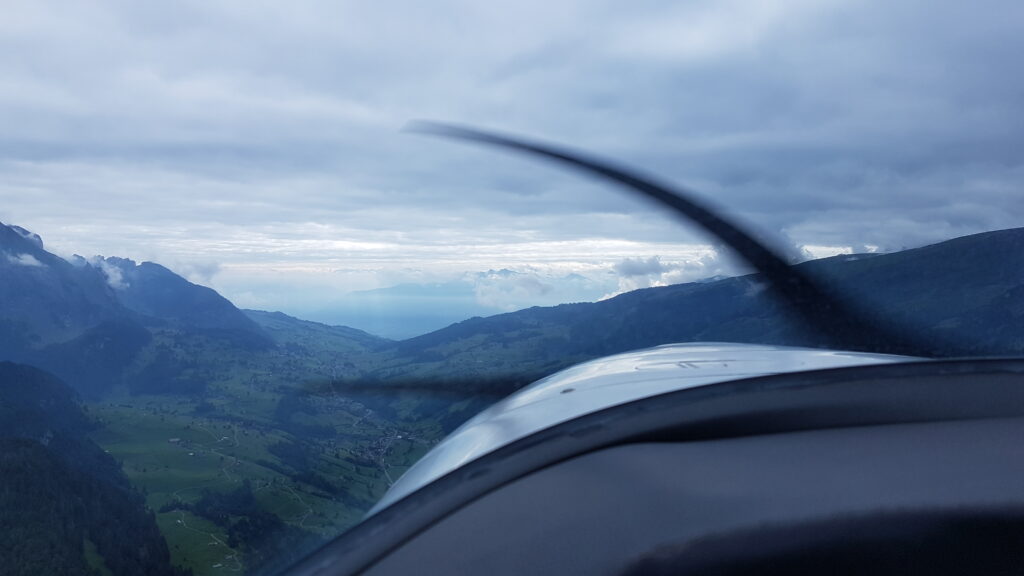
The holes in the cloud layer I have been hoping for started to become bigger as we approached Sargans, so we decided to give it a try and climbed though one of them.
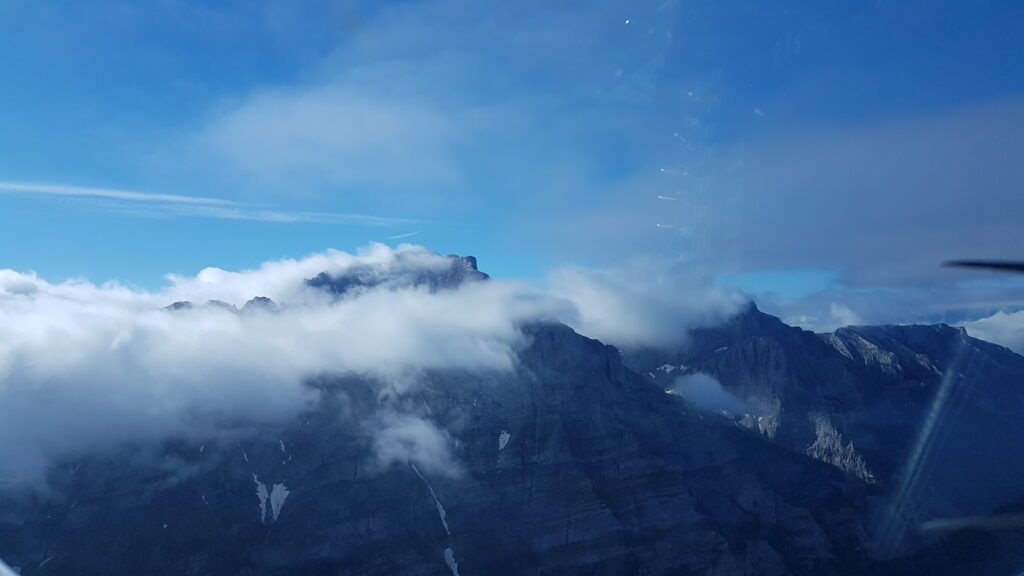
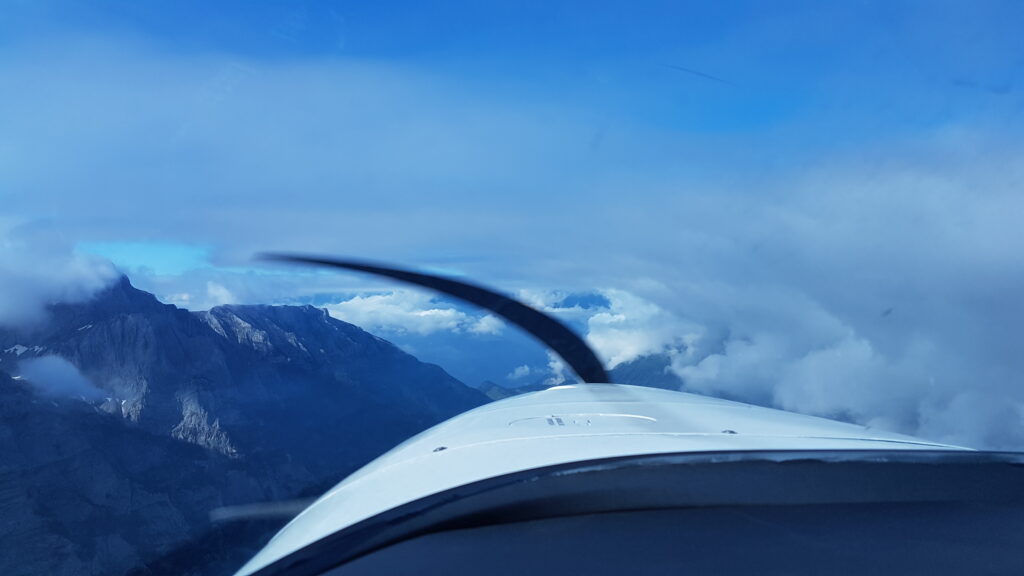
In Switzerland airspace G goes up to 2’000 ft above ground, and aircraft equipped with transponders only have to stay clear of clouds in this airspace. This helps for climbing through cloud layers, as it would be difficult to maintain the otherwise applicable 1.5 km horizontal and 300 m vertical distance to clouds. From more than 2’000 ft above ground airspace E is used over the alps in most areas, up to FL 130 or FL 150, if the air force is claiming that airspace. FL 130 or 150 however doesn’t matter for me, as I rarely fly higher than FL 120 anyway. And if I do so it is only for a short time, e.g. to fly around Matterhorn or some other mountains, but then I typically remain in airspace G anyway.
Once we had crossed the layer of clouds we were greeted by a spectacular view, with a nearly completely blue sky above us.
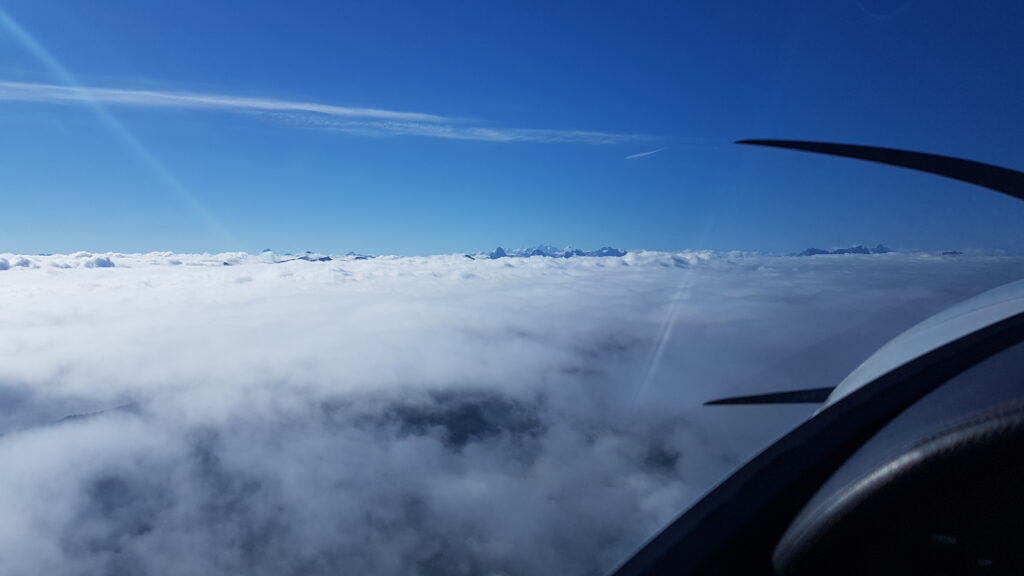
Flying on top of clouds is of course a certain risk, as in the case of an engine failure one would have to descent through the clouds. Even thought it doesn’t show well on the picture above we however always had sufficiently large holes in the cloud layer below us so that descending would always have been possible. And of course one also has to be sure that it is also possible to descent at the destination under VFR rules, or to turn back, so I normally don’t fly on top for more than maybe 10 to 20 miles.
Knowing in advance that I might try to fly on top due to the GAFOR prediction for the Julier pass I checked the local weather in Samedan before departure, including looking at the webcam of the airport. That confirmed that conditions were no problem in the Engadin valley. Looking ahead I could also already see this once we had climbed to above the clouds.
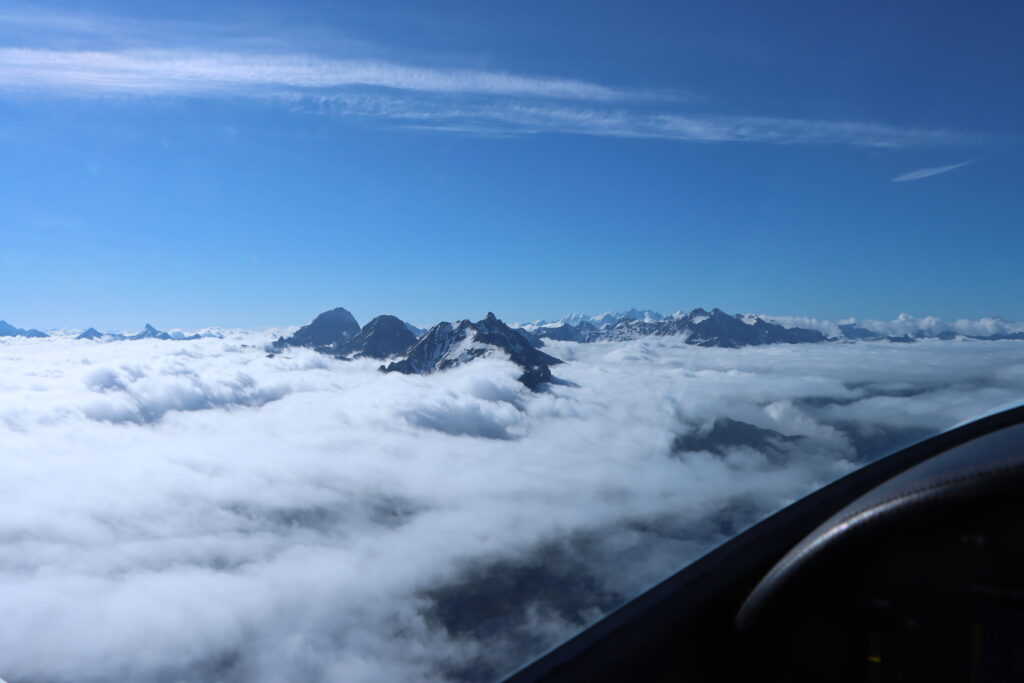
We crossed the Julier pass at around 10’000 ft instead of the minimum safe altitude of 8’600 ft, and were greeted by perfect VFR conditions once we had passed Silvaplana and turned into the Engadin valley toward St. Moritz.

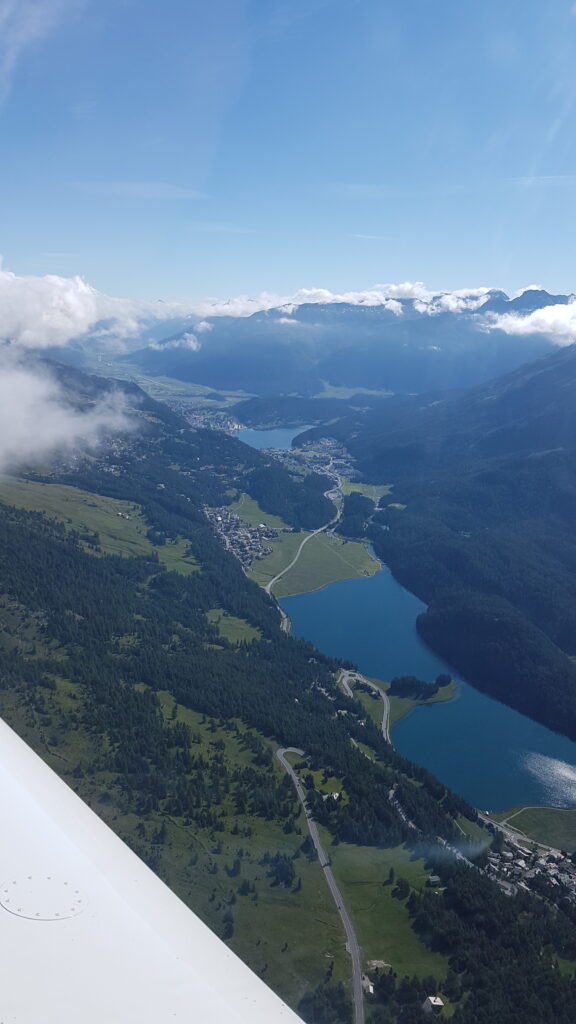
The weather forecast seemed to had kept many from flying to Samedan as early in the morning as we did, so we were the first VFR arrival of the day from north of the alps and got a straight in approach to runway 03. Below St. Moritz can be seen on the left, with the runway of Samedan airport in the background.

Below my plane, with the only two other planes on the apron visible in the background. M-AVIR is a Bombardier Global 6000, with an MTOM of 45’173 kg, compared to my 630 kg. I did a quick comparison of the landing / handling fees, that’s 27.9 CHF for me and about 14’000 CHF for the Bombardier Jet, plus around 3’000 CHF per day for parking… I definitely keep my SportCruiser.

We stayed for a coffee and then took off again, heading for a Pizza at the airport restaurant in Locarno.
We took off on Runway 03, then turned in to the downwind, heading south towards Maloja. Below a view down the Maloja pass and the Bregaglia valley towards Chiavenna, which lies in the Lombardy province in Italy. Chiavenna is a very nice little city of around 7’500 inhabitants, whoever passes is by car should plan a stop.

We then headed north through the Avers valley towards the San Berrnardino Pass, as the direct route to Locarno would have lead us through Italian air space and from what I have heard they don’t like it if you don’t file a flight plan. As soon as we left the Engadin valley the cloud coverage got thicker again, so when approaching the San Bernardino pass we decided to descent to below the still only broken layer.
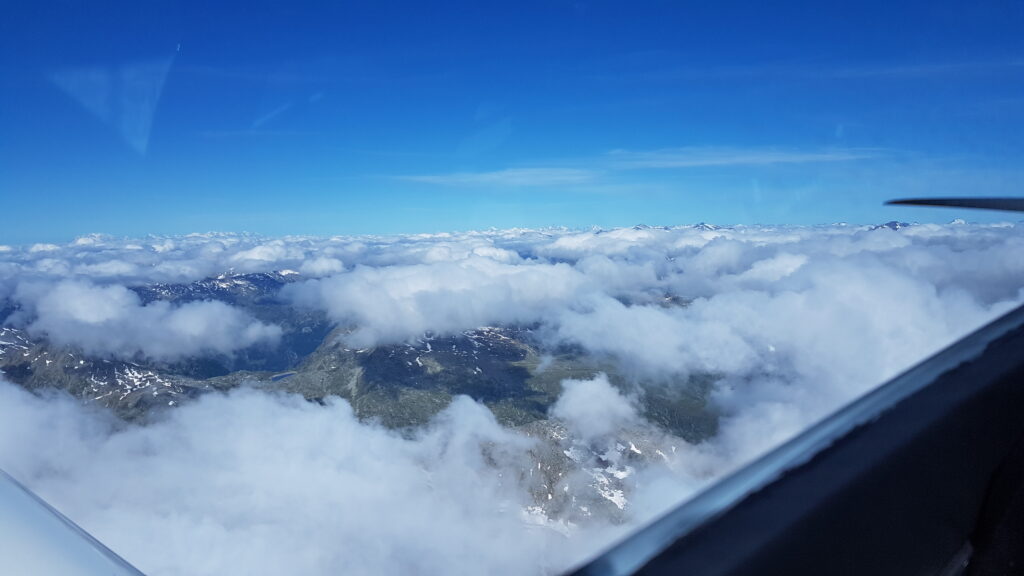
We anyway had to descend early as we were flying at around 11’000 ft, but Locarno is only at 650 ft AMS. That’s 5’000 ft lower than Samedan Aerodrome. Decending 9’500 ft at a comfortable rate of 500 ft/min takes nearly 20 minutes, or about 35 miles / 65 km.

Below a view of San Vittore aerodrome, which is still owned by the Swiss Air Force, but only used sporadically for some civil glider camps. Years ago a friend and I had tried to by it for an investor, but the local communities preferred to maintain the status quo. Maybe that will be a retirement project for me in a few years, if the investor is still interested.
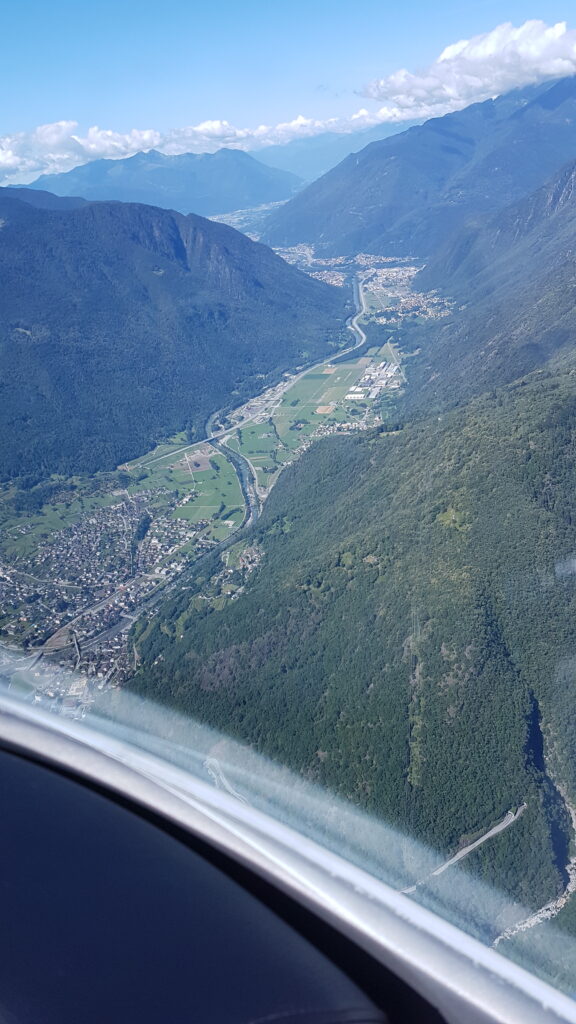
I expected a lot of traffic in Locarno, but the wasn’t the case. We got cleared for landing with a straight in approach to Runway 26R already many miles from the runway.
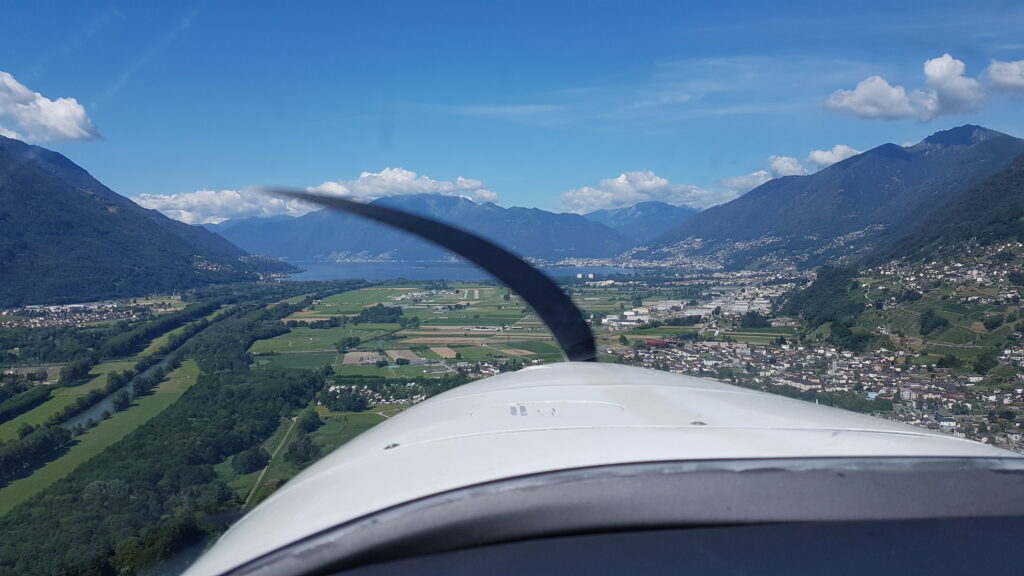
Locarno aerodrome is bigger than it looks, as it is the main training airbase for the Swiss Air Force’s Pilatus PC-7 fleet. It is however a dual use airport, which also handles quite some business jets, para-jumpers (both military and civil) and gliders. And of course tourists like me.
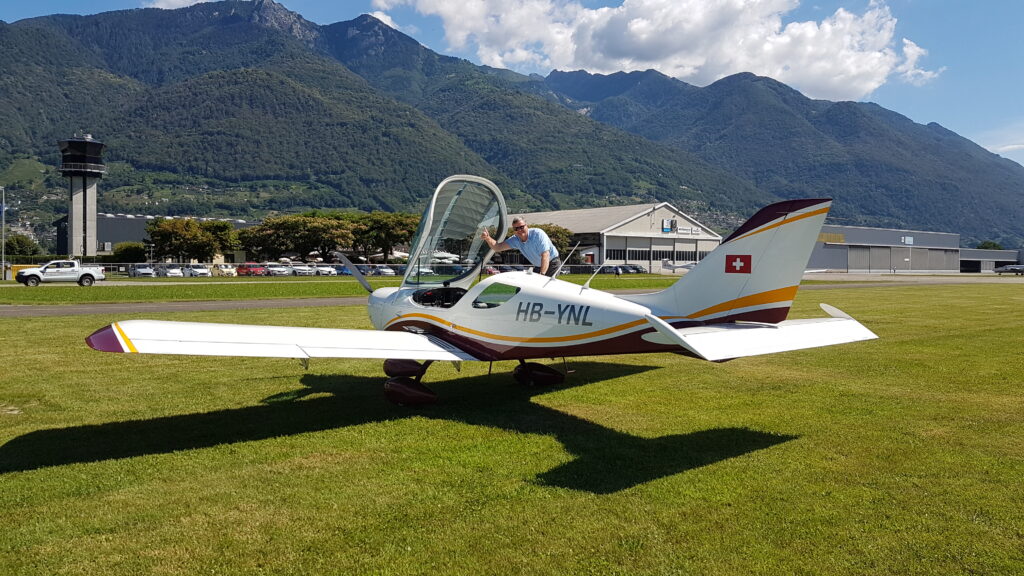
They have a very nice airport restaurant, where we did our planned Pizza stop (I recommend the Pizza Aeroporto), before heading back to Lommis. We took off from Runway 26R, did a turn around the Isole di Brissago, an island which was owned by some Russian-German baroness, followed by a German Tycoon before being bought by the Canton of Ticino. The old villa and the botanical garden created by the Tycoon still exist and are accessible for the public, another spot one has to visit when passing by.

We then turned north, heading up the Maggia valley, climbing from the 650 ft of the aerodrome back to about 10’000 ft over the Gotthard pass.
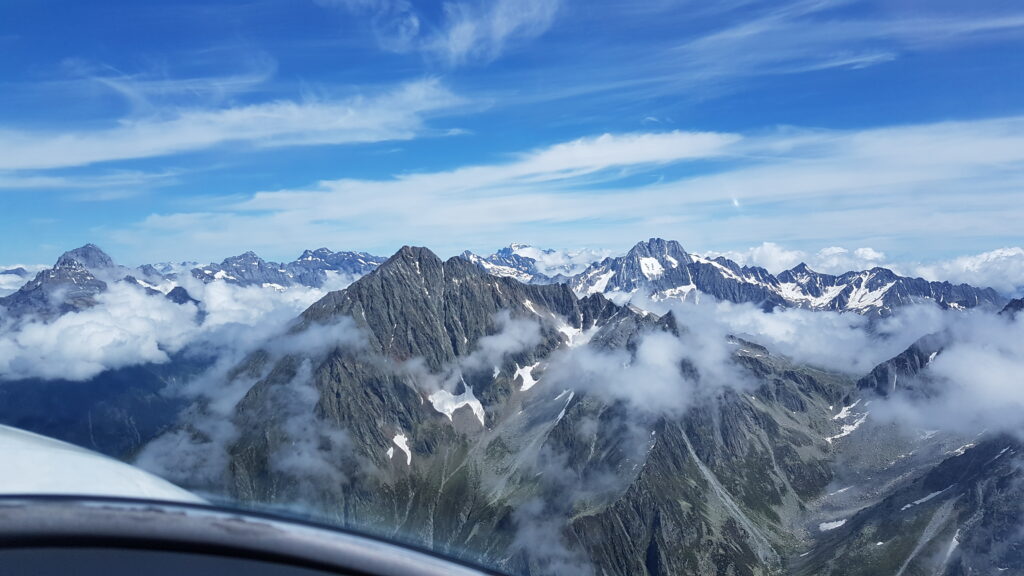
From there we turned north-east toward Lommis.

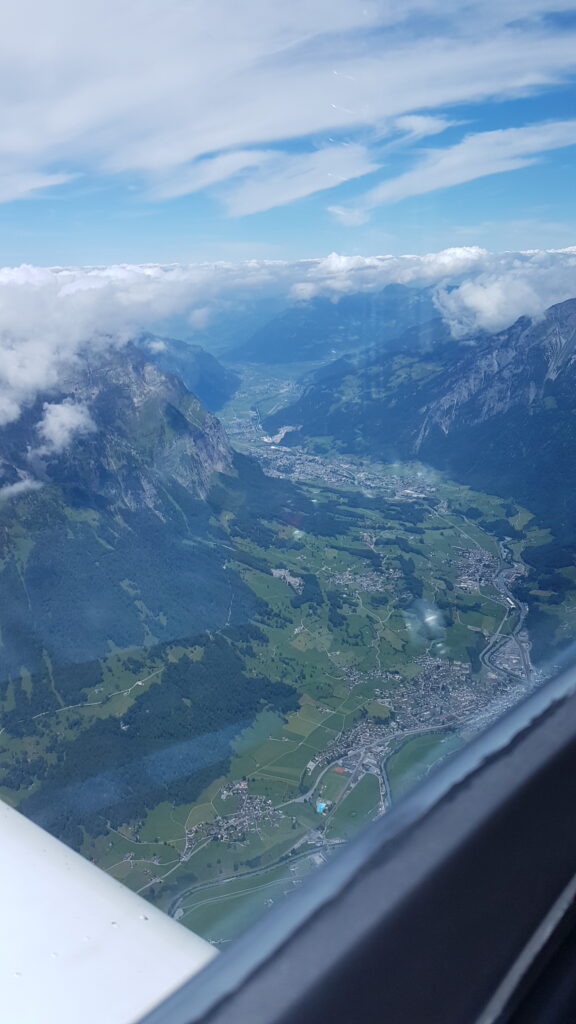
We had hardly opened the canopy after landing when Dani took off with his Bücker, I just manage to take a picture while still sitting in the plane.

09.07.2020: It was time again for the bi-annual inspection of my SportCruiser by the Swiss Federal Office of Civil Aviation (FOCA). Like two years ago the inspector found not a single issue, neither on the plane itself nor in the papers. Good to hear that I keep everything perfectly in order.